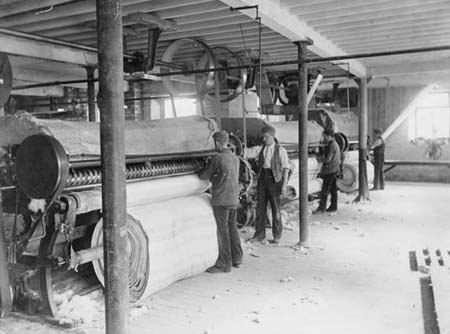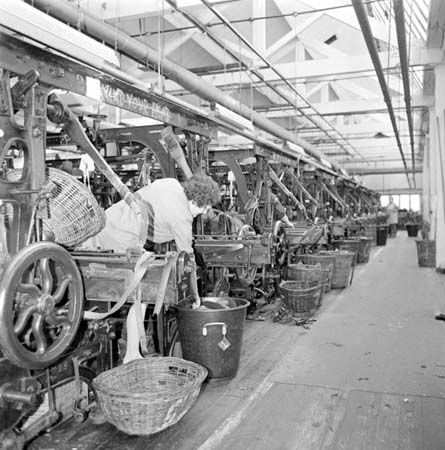

Health and safetyLike many industries, blanket making could be a dangerous occupation and it wasn't really until the 1970s and 1980s that health and safety began to be an important issue in the workplace. Accidents and injury  Men operating a raising machine at a Witney blanket mill. The man nearest the camera is putting his hands very close to an unguarded roller. Shuttles, which are heavy wooden objects with metal pointed ends, would often fly out from the end of loom at a tremendous speed and could cause serious injuries. Alan Pullin, a weft man at Smith and Philips' Bridge Street Mill in Witney, remembers walking down the passage way between the weaving sheds and seeing a shuttle come smashing through the window just a few yards ahead of him. Many of the weavers remember having 'near misses' and it was common for the windows in the weaving sheds to be replaced with boards where shuttles had broken the glass. Disease and occupational hazards  Some of the many looms in the weaving shed at Walker's Crofts Mill. Note how closely they are set together. Anthrax is a serious disease of sheep and cattle that can be passed onto humans; it is often fatal. It is not usually found in Britain but could be brought in on infected animal carcasses and wool. It was possible, although unusual, to pick it up through handling the wool intended for blanket making and it is sometimes known as 'woolsorter's disease'. A lot of the Witney workers remember quite startling posters hung up in the mills showing pictures of the nasty sores that could develop on your skin if you were unlucky enough to catch it. Peter Baston, an ex-wool buyer for Charles Early and Marriott, remembers from his childhood a mill worker in Witney coming down with anthrax but who was fortunate enough to survive it. The atmosphere in the Witney blanket mills cannot be compared to that of the cotton industry, where the air was laden with tiny particles of dust that the workers constantly breathed in, and where lung diseases such as byssinosis were common. Wool creates a certain amount of dust, but it is not generally fine enough to stay airborne for long. The use of rayon beginning in the 1950s was a problem, though: workers at Marriott's Mount Mills remember that you could see the rayon fibre in the air all the time but nobody wore masks as the dangers of breathing it were not recognised at the time. Dust and dirt particles were a problem in the carding and weaving sheds; in the latter the floors had to be scrubbed thoroughly at the end of each week to prevent the sticky build up of oily dust and debris. Fire hazards Oil was used in large quantities in the mills to lubricate both the machines and the wool, and build ups of highly inflammable oil-soaked dust had to be regularly cleaned down. In the 18th and 19th centuries candles and oil lamps were used as lighting, which may have been the cause of many fires. Smoking was generally banned throughout the mills because of the fire hazard. For that reason, snuff-taking was popular among the workers, especially the women weavers. In the 1950s the use of rayon at Marriott's Mount Mills caused a very serious fire. Rayon is a synthetic fibre which breaks up into very fine combustible particles; this hangs in the air and accumulates in the equipment and a single spark or the friction created by the machines could ignite it.
|
|
| Listen: Download audio file Alan Pullin, a 'weft man' for Smith and Philips' blanket company (1964-1974) recalls the noise of the weaving sheds (159Kb). Download audio file Yvonne Souch, a former worker from the Witney blanket industry, demonstrates how weavers would get each other's attention over the noise of the looms (25Kb). Download audio file Alan Pullin describes how a shuttle could fly out of the loom sometimes causing injury (98Kb). |
|
